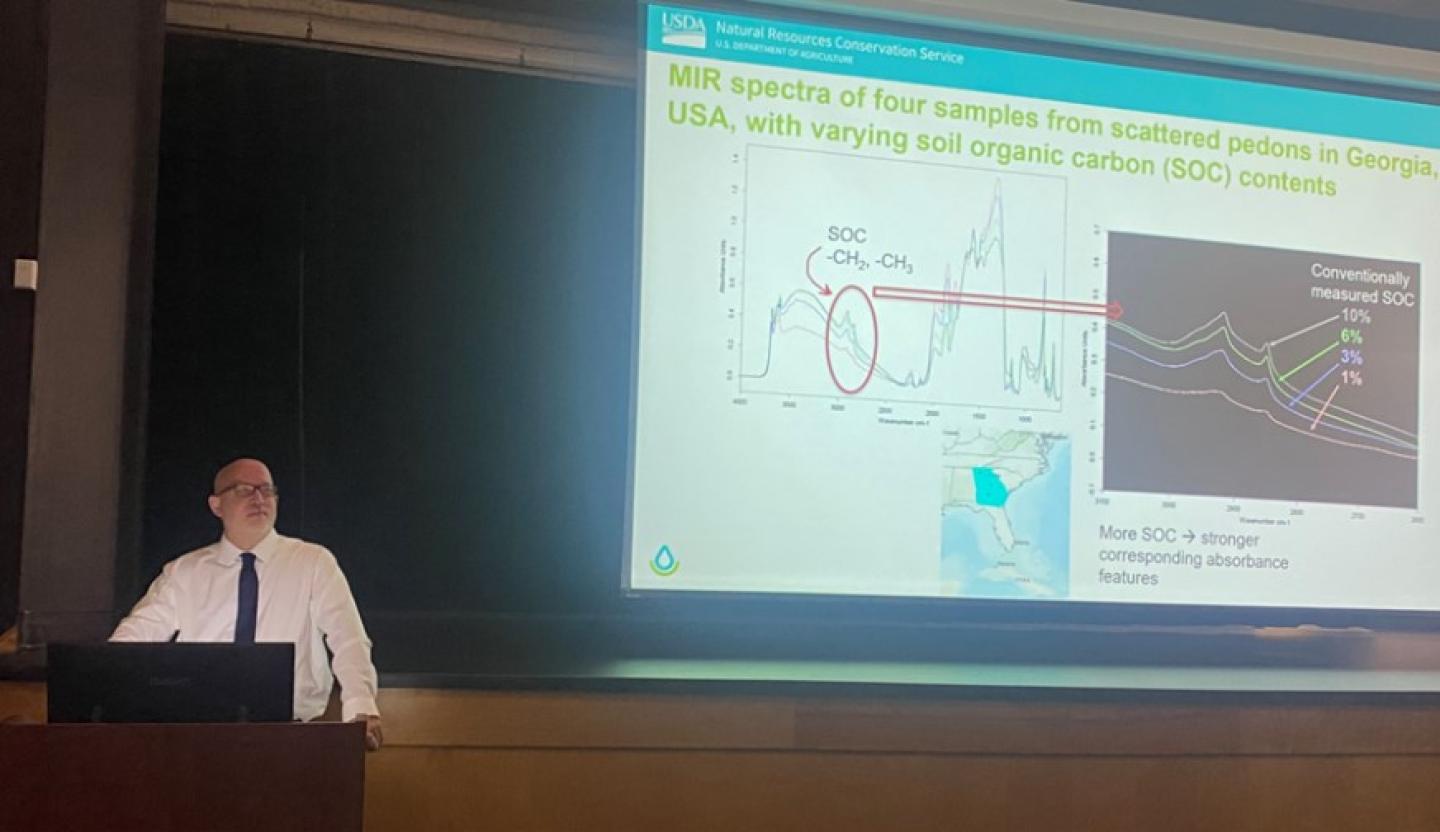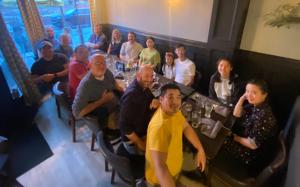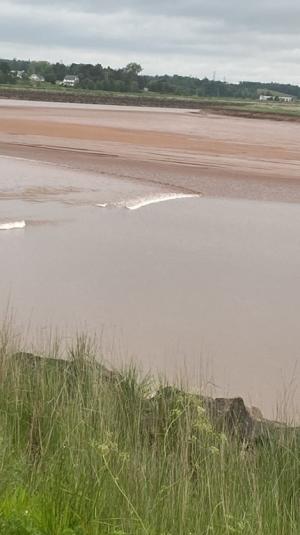Infrared Spectroscopy Program
Chemist Rich Ferguson has led the Kellogg Soil Survey Laboratory MIR data collection, participated in diverse collaborative research activities on soil IR spectroscopy, and trained many scientists inside and outside NRCS to understand and use soil IR spectroscopy.
NRCS-SPSD Infrared Spectroscopy Program Highlighted in Keynote Address at the 2023 Annual Meeting of the Canadian Society of Soil Science

Since the 1980s, the soil science community has seen increasing interest in developing soil infrared (IR) spectroscopy for rapid, reliable soil assessment. Soil properties such as clay, organic matter, and carbonates absorb IR radiation at various wavelengths, in general proportion to their levels in the soil. On a conceptual basis, calibrating an IR spectrometer to estimate a soil property is analogous to calibrating a pH meter. A key difference is that instead of the single instrument response of a pH meter for each calibration standard, an IR spectrum comprises hundreds of overlapping instrument responses pertaining to different soil properties, requiring a higher order of calibration method. Proof-of-concept is now well-established for using soil IR spectroscopy to estimate many key soil properties, and soil IR spectroscopy is seeing global commercial and institutional use both as a laboratory method and for proximal (in field) sensing. The global soil IR spectroscopy community continues to organize and work more together as soil IR spectroscopy remains a cutting-edge field of applied research.
NRCS invested in soil IR spectroscopy based on proofs-of-concept established by trailblazers, many outside the USA–in Africa, Europe, Australia, and South America–and on realization that most of the hard work needed to prepare soil IR calibrations had already been done: soil samples had been collected, described, analyzed and stored in the national soil archive of the Kellogg Soil Survey Laboratory (KSSL). In 2006 and 2011 respectively, KSSL began collecting visible near-infrared (VNIR – 750 to 2,500 nm) and mid-infrared (MIR – 2,500 to 25,000 nm) spectra on georeferenced KSSL samples to capture the compositional and spectral variability of soils across the USA, the goal being to prepare local calibrations. Using available IR technologies, the KSSL observed that MIR calibrations offered low, acceptable errors and reliable calibrations. Within NRCS-SPSD, MIR technology was first successfully introduced at the Salina, KS field office; results were documented by Seybold et al. As of 2023, MIR spectrometry has been deployed to multiple NRCS-SPSD field offices from Puerto Rico to Alaska.

One of multiple networking suppers during which Rich got to talk shop with a broad cross-section of Canadian scientists.
Globally, USDA-NRCS scientific standards are held in high esteem, including standards for soil analysis. NRCS-SPSD investing in soil IR spectroscopy thus added a significant impetus to the forward momentum that soil IR spectroscopy already had, further energizing and enlarging the discipline. Thanks to the USDA open data policy, global researchers have been conducting previously unachievable experiments using diverse, high-quality KSSL spectral and reference data. Over the last decade, KSSL chemist Rich Ferguson has led the KSSL MIR data collection, participated in diverse collaborative research activities on soil IR spectroscopy, and trained many scientists inside and outside NRCS to understand and use soil IR spectroscopy. For two years, Rich has also served on the advisory board of the USDA-NIFA project, “Soil Spectroscopy for Global Good.” In 2018, SPSD Director Dave Lindbo began partnering SPSD with the Food and Agricultural (FAO) Global Soil Partnership (GSP), to encourage participation in discussions with global stakeholders on standards for doing soil science. In 2020, that partnership paved the way for Rich, together with soil IR spectroscopy trailblazer Keith Shepherd, International Soil Reference and Information Centre (ISRIC) scientist Fenny van Egmond, NRCS-SPSD NSSC Director Dave Hoover, Woodwell Climate Research Center scientist Jonathan Sanderman, and University of Nebraska-Lincoln Professor Yufeng Ge, to play co-founding roles in the development of the soil IR spectroscopy outreach program of the FAO-GSP Global Soil Laboratory Network (GLOSOLAN). Among other initiatives around conventional soil analysis, GLOSOLAN also promotes soil IR spectroscopy as a reliable and cost-effective method for estimating several key soil properties.

Rich was invited to present a one hour keynote address on the topic of soil IR spectroscopy at the 2023 annual meeting of the Canadian Society of Soil Science (CSSS), the overall theme of which was “Soils Go Digital.” The CSSS meeting took place June 25-29, 2023, at Dalhousie University in Truro, Nova Scotia; over 250 Canadian scientists attended. Rich’s talk was entitled, “Overview of Infrared Spectroscopy for Estimating Soil Properties.” Rich also led two soil IR spectroscopy workshops, and on the Friday after the conference (June 30), Rich spent a day with graduate students, post-docs, and faculty doing soil IR spectroscopy research. Overall, Rich represented NRCS-SPSD expertise in computational chemistry and soil IR spectroscopy. Based on Rich’s interactions with a broad cross-section of conferees, a clear benefit to Canada was Rich’s qualified support for progressive and organized soil IR spectroscopy science taking place in Canada. During the rest of the conference, many individual scientists approached and interacted with Rich on a variety of soil spectroscopy topics. Some were soil spectroscopists expressing appreciation for filling gaps in their tacit knowledge base. Some had no experience in soil spectroscopy, expressing appreciation for shedding light on the work of the soil IR spectroscopy community. Some expressed brand new interest in doing soil spectroscopy. Some self-described skeptics said they could now support soil spectroscopy as a soil assessment method. The state of NRCS-SPSD investment in soil IR spectroscopy impressed many conferees, and Rich attended a luncheon with a group of scientists interested in developing an inter-provincial soil spectroscopy program. Rich especially enjoyed working with grad students, post-docs, and faculty doing soil IR spectroscopy research, identifying productive avenues for applied research.
At the CSSS meeting, Rich highlighted the efforts of NRCS-SPSD scientists who’ve made soil IR spectroscopy an increasingly viable alternative to conventional analysis inside and outside NRCS-SPSD. Soil IR calibrations are built on KSSL data that represent the work of a great many NRCS-SPSD staff who, over time, collected, described, and analyzed soil samples, mostly unaware that such efforts would eventually serve a cutting-edge soil IR spectroscopy program. With the KSSL soil archive and data, and with the supportive management culture of NRCS-SPSD, soil IR spectroscopy has gotten off the ground at several NRCS-SPSD field offices. Additionally, the NRCS-SPSD Technology Focus Team includes an MIR subteam led by KSSL Soil Scientist Andrea Williams, who, together with Texas-based Major Land Resource Area Soil Survey Leader Travis Waiser, provides training and support to SPSD field offices onboarding MIR technology.
Star Trek fans all know about the “Tricorder,” the proximal sensor that Mr. Spock used for analyzing everything, including geologic samples; by pointing the Tricorder at a sample, it would inform the user about the composition or condition of the sample. From when Star Trek first appeared on TV in the 1960s until today, the Tricorder – along with warp drives, energy shields, phasers, and transporter beams – are technologies that exist only in the imagination. In 2023, however, previously unthinkable computational capacity is now readily accessible, and the latest iPhone exceeds the performance of the multi-million dollar, room-sized supercomputers of the 1990s. It is that computational capacity, as well as advances in infrared optics, that have made soil IR spectroscopy a reality, and the Tricorder now appears within the realm of possibility as a device that makes predictions based on the statistical modeling of legacy data. It’s another feather in the cap of NRCS-SPSD that it helps lead and facilitate such developments. It’s only going to keep getting better, and the future shall see what comes next!

